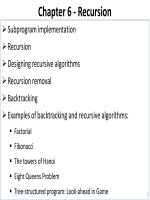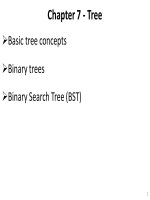Data structures and algorithm Array
Bạn đang xem bản rút gọn của tài liệu. Xem và tải ngay bản đầy đủ của tài liệu tại đây (1.29 MB, 34 trang )
Data structures and algorithm
Array Data Structure
Arrays are similar to list. Only difference is
The access. Once an array is created, its size cannot be changed.
List access in sequentially and Arrays are
Can be accessed by random.
The entire contents of an array are identified by a single name.
Individual elements within the array can be accessed directly by
specifying an integer subscript or index value, which indicates an
offset from the start of the array
Disadvantages of Array
Fixed size: The size of the array is static (specify the array
size before using it, this can be overcome using Dynamic
Arrays).
One block allocation: To allocate the array itself at the
beginning, sometimes it may not be possible to get the
memory for the complete array (if the array size is big).
Complex position-based insertion: To insert an element at
a given position, we may need to shift the existing
elements. This will create a position for us to insert the
new element at the desired position. If the position at
which we want to add an element is at the beginning, then
the shifting operation is more expensive
Linked list
Like arrays, Linked List is a linear data structure.
Unlike arrays, linked list elements are not stored at a
contiguous location(sharing border);
the elements are linked using pointers.
Why Linked List?
Arrays can be used to store linear data of similar
types, but arrays have the following limitations.
1) The size of the arrays is fixed:
2) Inserting a new element in an array of elements is
expensive because the room has to be created for the
new elements and to create room existing elements
have to be shifted.
Representation
A linked list is represented by a pointer to the
first node of the linked list. The first node is called
the head. If the linked list is empty, then the value
of the head is NULL.
Each node in a list consists of at least two parts:
1) data
2) Pointer (Or Reference) to the next node
Print the data in linked list
Examples of linked list-Adding Front
Adding the data at End
Inserting data between nodes
Stacks
Stack is a linear data structure which follows a
particular order in which the operations are
performed.
The order may be LIFO(Last In First Out) or
FILO(First In Last Out).
Push: Adds an item in the stack. If the stack is full, then it is said
to be an Overflow condition.
Pop: Removes an item from the stack. The items are popped in
the reversed order in which they are pushed. If the stack is
empty, then it is said to be an Underflow condition.
Peek or Top: Returns top element of stack.
isEmpty: Returns true if stack is empty, else false
Searching
Searching is the process of selecting particular
information from a collection of data based on specific
criteria.
The Linear Search:
The simplest solution to the sequence search problem
is the sequential or linear search algorithm.
Finding the smallest value
The Binary Search
The binary search algorithm works in a similar fashion
to the process described above and can be applied to
a sorted sequence.
The algorithm starts by examining the middle item of
the sorted sequence, resulting in one of three
possible conditions:
the middle item is the target value, the target value is
less than the middle item, or the target is larger than
the middle item
Linked Structures
Linked list
Now, suppose we add a second data field to
the ListNode class:
How to remove the node from linked list
Stacks









